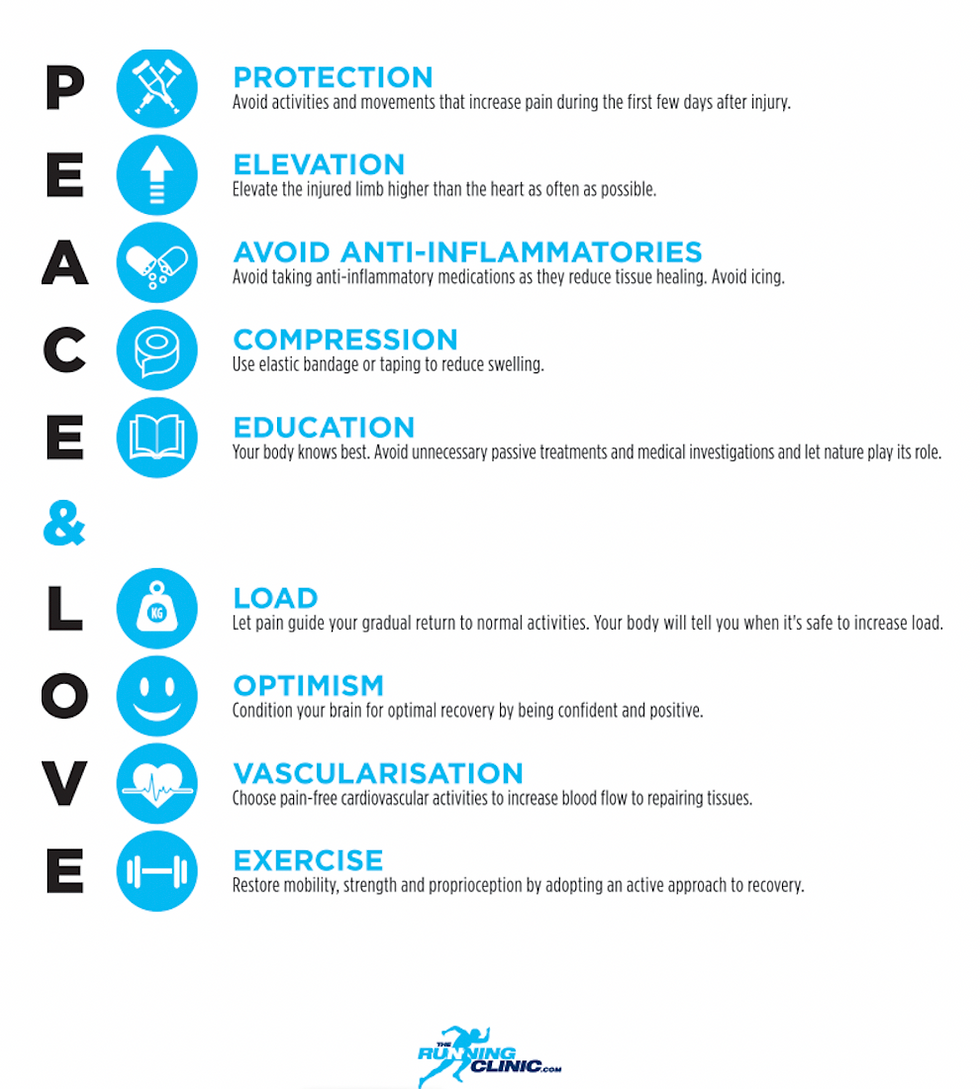All you need is PEACE and LOVE- The new standard of care for soft-tissue injuries
- Dr. Nicole Ballantyne

- Sep 27, 2022
- 3 min read
Rehabilitation and care of soft-tissue injuries can be complicated. Over the years, popular acronyms such as RICE and PRICE have guided the management of injuries. Although widely known, these previous acronyms focus on only acute management, unfortunately ignoring the further stages of tissue healing.
Therefore, a new acronym has been adopted in order to encompass care across the recovery continuum. Because sometimes, all you need is a little PEACE and LOVE.

Immediately after injury, do no harm and let PEACE guide your approach.
P for Protect:
Unload or restrict movement for 1–3 days to minimise bleeding and reduce the risk of aggravating the injury. Rest should be minimised as prolonged rest can compromise tissue strength and quality. Pain should guide the return to activity.
E for Elevate:
Elevate the limb higher than the heart to promote fluid flow out of tissues. Despite weak evidence supporting its use, elevation shows a low risk-to-benefit ratio.
A for Avoid anti-inflammatory modalities such as anti-inflammatory medication or ice:
The various phases of inflammation help repair damaged soft tissues. Therefore, inhibiting or delaying inflammation using medications may negatively affect long-term tissue healing. Standard of care for soft-tissue injuries should not include anti-inflammatory medications.
Further, despite widespread use among athletes and the general population, there is no high-quality evidence on the efficacy of ice for treating soft-tissue injuries. Even though ice can be pain relieving, ice could potentially disrupt inflammation, the formation of new blood vessel, the restoration of blood flow, and delay our natural immune response.
While some inflammation may be warranted for recovery, too much or prolonged swelling should be avoided. Excessive swelling applies unwanted pressure on tissues, restricts movement and can cause an increase in pain. This is often seen after severe joint sprains such as an ankle sprain, or following surgeries such as an ACL reconstruction. In these cases, ice may be of benefit, as the goal is to limit the extent of swelling. In comparison, muscle strains, such as a hamstring or quad strain, often create less swelling and are therefore less likely to benefit from ice.
C for Compress:
External compression using taping, bandages or compression sleeves help limit joint swelling and tissue bleeding.
E for Educate:
Therapists should educate patients on the benefits of an active approach to recovery. Passive modalities, such as electrotherapy, manual therapy or acupuncture, early after injury have insignificant effects on pain and function compared with an active approach. Indeed, nurturing an external locus of control or the ‘need to be fixed’ can lead to therapy-dependent behaviour. Better education on the condition and load management will help avoid overtreatment.

After the first days have passed, soft tissues need LOVE.
L for Load:
An active approach with movement and exercise benefits most patients with musculoskeletal disorders or injuries. Mechanical stress should be added early and normal activities resumed as soon as symptoms allow. Optimal loading without exacerbating pain promotes repair, remodeling and builds tissue tolerance and the capacity of tendons, muscles and ligaments.
O for Optimism:
Optimistic patient expectations are associated with better outcomes and prognosis. Psychological factors such as catastrophization, depression and fear can represent barriers to recovery.
V for Vascularization:
Cardiovascular activity or exercise, such as walking, running or biking, is a key factor in the management of musculoskeletal injuries. While research is needed on dosage, pain-free aerobic exercise should be started a few days after injury to boost motivation and increase blood flow to the injured structures.
E for Exercise:
Exercises help to restore mobility and strength early after injury. Pain should be avoided to ensure optimal repair during recovery and should be used as a guide for progressing exercise.
Managing soft-tissue injuries is more than short-term damage control. Similar to other injuries, clinicians and patients should aim for good long-term outcomes and treat the person with the injury rather than the injury of the person.
Whether you are dealing with an ankle sprain or a hamstring strain, I hope you give PEACE a chance, because perhaps all soft-tissue injuries need is LOVE.
Resources:
Dubois B, Esculier J-F. Br J Sports Med 2020;54:72–73.






Comments